
Hydrogeology is the area of geology that deals with the distribution and movement of groundwater in the soil and rocks of the Earth's crust. The terms groundwater hydrology, geohydrology, and hydrogeology are often used interchangeably, though hydrogeology is the most commonly used.
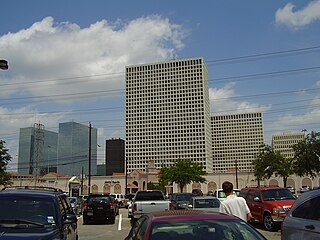
Transocean Ltd. is an American drilling company. It is the world's largest offshore drilling contractor based on revenue and is based in Vernier, Switzerland. The company has offices in 20 countries, including Canada, the United States, Norway, United Kingdom, India, Brazil, Singapore, Indonesia, and Malaysia.

Ixtoc 1 was an exploratory oil well being drilled by the semi-submersible drilling rig Sedco 135 in the Bay of Campeche of the Gulf of Mexico, about 100 km (62 mi) northwest of Ciudad del Carmen, Campeche in waters 50 m (164 ft) deep. On 3 June 1979, the well suffered a blowout resulting in the largest oil spill in history at its time. To-date, it remains the second largest oil spill in history after the Deepwater Horizon oil spill.
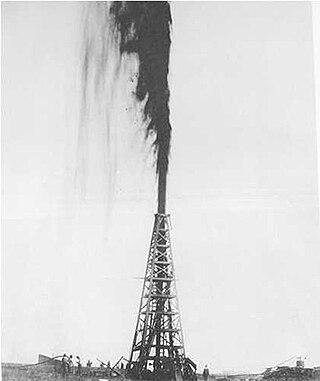
A blowout is the uncontrolled release of crude oil and/or natural gas from an oil well or gas well after pressure control systems have failed. Modern wells have blowout preventers intended to prevent such an occurrence. An accidental spark during a blowout can lead to a catastrophic oil or gas fire.
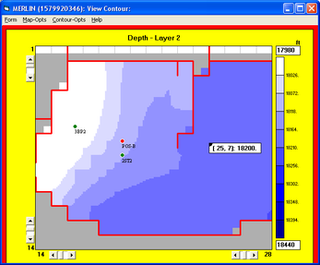
Reservoir simulation is an area of reservoir engineering in which computer models are used to predict the flow of fluids through porous media.
Groundwater models are computer models of groundwater flow systems, and are used by hydrologists and hydrogeologists. Groundwater models are used to simulate and predict aquifer conditions.

Deepwater Horizon was an ultra-deepwater, dynamically positioned, semi-submersible offshore drilling rig owned by Transocean and operated by the BP company. On April 20, 2010, while drilling in the Gulf of Mexico at the Macondo Prospect, a blowout caused an explosion on the rig that killed 11 crewmen and ignited a fireball visible from 40 miles (64 km) away. The fire was inextinguishable and, two days later, on April 22, the Horizon collapsed, leaving the well gushing at the seabed and becoming the largest marine oil spill in history.

Deepwater drilling, or deep well drilling, is the process of creating holes in the Earth's crust using a drilling rig for oil extraction under the deep sea. There are approximately 3400 deepwater wells in the Gulf of Mexico with depths greater than 150 meters.
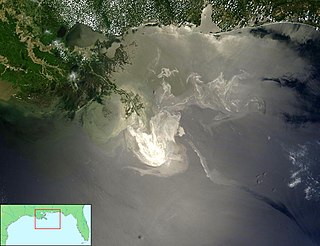
The Deepwater Horizon oil spill was an environmental disaster which began on 20 April 2010, off the coast of the United States in the Gulf of Mexico on the BP-operated Macondo Prospect, considered the largest marine oil spill in the history of the petroleum industry and estimated to be 8 to 31 percent larger in volume than the previous largest, the Ixtoc I oil spill, also in the Gulf of Mexico. Caused in the aftermath of a blowout and explosion on the Deepwater Horizon oil platform, the United States federal government estimated the total discharge at 4.9 MMbbl. After several failed efforts to contain the flow, the well was declared sealed on 19 September 2010. Reports in early 2012 indicated that the well site was still leaking. The Deepwater Horizon oil spill is regarded as one of the largest environmental disasters in world history.
The Macondo Prospect is an oil and gas prospect in the United States Exclusive Economic Zone of the Gulf of Mexico, off the coast of Louisiana. The prospect was the site of the Deepwater Horizon drilling rig explosion in April 2010 that led to a major oil spill in the region from the first exploration well, named itself MC252-1, which had been designed to investigate the existence of the prospect.

On April 20, 2010, an explosion and fire occurred on the Deepwater Horizon semi-submersible mobile offshore drilling unit, which was owned and operated by Transocean and drilling for BP in the Macondo Prospect oil field about 40 miles (64 km) southeast off the Louisiana coast. The explosion and subsequent fire resulted in the sinking of the Deepwater Horizon and the deaths of 11 workers; 17 others were injured. The same blowout that caused the explosion also caused an oil well fire and a massive offshore oil spill in the Gulf of Mexico, considered the largest accidental marine oil spill in the world, and the largest environmental disaster in United States history.
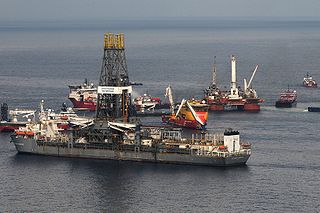
The following is a timeline of the Deepwater Horizon oil spill. It was a massive oil spill in the Gulf of Mexico, the largest offshore spill in U.S. history. It was a result of the well blowout that began with the Deepwater Horizon drilling rig explosion on April 20, 2010.

Offshore oil spill prevention and response is the study and practice of reducing the number of offshore incidents that release oil or hazardous substances into the environment and limiting the amount released during those incidents.
Following is a Timeline of the Deepwater Horizon oil spill for May 2010.
The Back to Work Coalition is a group of twelve offshore oil and gas industry stakeholders and trade associations, that have banded together to oppose the federal and regulatory policies placed on the industry following the Deepwater Horizon oil well explosion of April 2010. After the explosion, the Obama administration imposed a federal moratorium on deepwater drilling that lasted through mid-October 2010. The Back to Work Coalition was created in December 2010 to combat what the members believe is a "de facto" moratorium, caused by the federal government's hesitance in issuing drilling permits on the gulf's Outer Continental Shelf (OCS). The coalition was founded by Louisiana Department of Natural Resources (DNR) Secretary Scott Angelle. The coalition is facilitated by the Gulf Economic Survival Team (GEST), a non-profit organization created to restore Louisiana's economy following the moratorium.
Oil spill governance in the United States is governed by federal law.

Arctic Challenger is a barge which has been converted by Superior Energy Services for use in the Arctic drilling operations of Shell Oil Company. This barge is designed to function as a "novel engineering solution" which they refer to as an Arctic Containment System to respond should a blowout event occur at drilling sites in the Beaufort or Chukchi Seas. According to testimony provided to Senator Mark Begich on 11 October 2012, Coast Guard Rear Admiral Thomas Ostebo said the certification for the Shell spill barge Arctic Challenger to operate in Alaska was given on the 10th of October at the Bellingham, Washington shipyard where it was constructed. Ostebo is commander of the Coast Guard's 17th district, which covers Alaska.

The Deepwater Horizon investigation included several investigations and commissions, among others reports by National Incident Commander Thad Allen, United States Coast Guard, National Commission on the BP Deepwater Horizon Oil Spill and Offshore Drilling, Bureau of Ocean Energy Management, Regulation and Enforcement, National Academy of Engineering, National Research Council, Government Accountability Office, National Oil Spill Commission, and Chemical Safety and Hazard Investigation Board.

The Deepwater Horizon oil spill was discovered on the afternoon of 22 April 2010 when a large oil slick began to spread at the former rig site. According to the Flow Rate Technical Group, the leak amounted to about 4.9 million barrels of oil, exceeding the 1989 Exxon Valdez oil spill as the largest ever to originate in U.S.-controlled waters and the 1979 Ixtoc I oil spill as the largest spill in the Gulf of Mexico. BP has challenged this calculation saying that it is overestimated as it includes over 810,000 barrels of oil which was collected before it could enter the Gulf waters.
HWCG LLC is a non-profit consortium of deep water oil and gas companies. HWCG maintains a comprehensive deepwater well containment response model that can be activated immediately in the event of a US Gulf of Mexico subsea blowout. It comprises oil and gas companies operating in the Gulf and incorporates the consortium’s generic well containment plan. HWCG has a healthy mutual aid component whereby HWCG members will respond and support another member’s incident.











